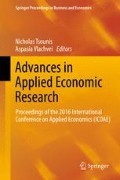Abstract
Capital asset pricing model (CAPM) is one of the most significant models in finance. The expected return for a stock is related to Beta which is the measure of market especially systematic risk. Recent researches show that Beta calculated by CAPM is very sensitive variable. Many studies have investigated the influence of variables to Beta, e.g., credit rating. The credit rating agencies as providers of information have a crucial importance for market participants and regulators. The aim of this contribution is to present the key studies examined linkage between credit rating and systematic risk as well as to present CAPM model, credit rating measures and their advantages and disadvantage.
Access this chapter
Tax calculation will be finalised at checkout
Purchases are for personal use only
References
Abad-Romero P, Robles-Fernandez MD (2006) Risk and returns around bond rating changes: new evidence from the Spanish stock market. J Bus Financ Account 33(5 & 6):885–908
Brealey RA, Myers SC, Allen F (2010) Principles of corporate finance, 10th edn. McGraw-Hill/Irwin, New York
Buc D, Kliestik T (2013) Aspects of statistics in terms of financial modelling and risk. In: 7th international days of statistics and economics, Prague, Czech Republic, pp 215–224
Cisko S, Kliestik T (2013) Financny manazment podniku II. EDIS Publishing, Zilina, pp 231–775
Dengov VV, Gregova E (2010) Economic decision-making under uncertainty and risk. Methodology and criteria for decision-making. Ekonomicko-manazerske spektrum 4(2):28–45
Dichev I, Piotroski J (2001) The long-run stock returns following bond ratings changes. J Financ 56:173–203
Elton EJ et al (2003) Modern portfolio theory and investment analysis, 6th edn. Wiley, New York
European Central Bank (2004) Market dynamics associated with credit risk, a literature review. Occasional Paper Series
Goh JC, Ederington LH (1993) Is a bond rating downgrade bad news, good news, or no news for stockholders? J Financ 48(5):2001–2008
Grublova E (2010) Attitudes to risk and ability to take risky decisions. Ekon manazerske spektrum 4(2):58–63
Hand JRM, Holthausen RW, Leftwich RW (1992) The effect of bond rating agency announcements on bond and stock prices. J Financ 4:733–752
Impson CM, Karafiath I, Glascock J (1992) Testing beta stationarity across bond rating changes. Financ Rev 27(4):607–618
Jiang JX, Stanford MH, Xie Y (2011) Does it matter who pays for bond ratings? historical evidence. J Financ Econ (JFE), Forthcoming; Fordham University School of Business Research Paper
Kliestik T, Misankova M, Adamko P (2014) Sensitivity analysis of credit risk models based on Greeks. In: 2nd international conference on management innovation and business innovation (ICMIBI 2014), Lecture Notes in Management Science, Bangkok, Thailand, vol 44. pp 99–104
Kliestik T, Musa H, Frajtova-Michalikova K (2015) Parametric methods for estimating the level of risk in finance. Procedia Econ Financ 24:322–330
Lintner J (1965) The valuation of risk assets and the selection of risky investments in stock portfolios and capital budgets. Rev Econ Stat 47:13–37
Markowitz H (1952) Portfolio selection. J Financ 7(1):77–91
Misankova M, Kral P (2015) Application of CreditRisk + for the calculation of credit risk. In: 10th international scientific conference financial management of firms and financial institutions, Ostrava, pp 807–814
Mossin J (1966) Equilibrium in a capital asset market. Econometrica 34(4):768–783
Schwendiman CJ, Pinches GE (1975) An analysis of alternative measures of investment risk. J Financ XXX(1):193–200
Sharpe WF (1964) Capital asset prices: a theory of market equilibrium under conditions of risk. J Financ 19:425–442
Sivak R, Gertler L, Kovac U (2015) Teoria a politika rizika vo financiach a v bankovnictve., Bratislava, Sprint 2
Spuchlakova E, Valaskova K, Adamko P (2015) The credit risk and its measurement, hedging and monitoring. Proc Econ Financ 24:675–681
Valaskova K, Gavlakova P, Dengov V (2014) Assessing credit risk by Moody’s KMV model. In: 2nd international conference on economics and social science (ICESS), Advances in Education Research, Shenzhen, vol 61. pp 40–44
Zaima JK, McCarthy J (1988) The impact of bond rating changes on common stocks and bonds: tests of the wealth redistribution hypothesis. Financ Rev 23(4):483–498
Acknowledgements
The contribution is an output of the science project VEGA 1/0656/14—Research of Possibilities of Credit Default Models Application in Conditions of the SR as a Tool for Objective Quantification of Businesses Credit Risks.
Author information
Authors and Affiliations
Corresponding author
Editor information
Editors and Affiliations
Rights and permissions
Copyright information
© 2017 Springer International Publishing AG
About this paper
Cite this paper
Michalkova, L., Kramarova, K. (2017). CAPM Model, Beta and Relationship with Credit Rating. In: Tsounis, N., Vlachvei, A. (eds) Advances in Applied Economic Research. Springer Proceedings in Business and Economics. Springer, Cham. https://doi.org/10.1007/978-3-319-48454-9_43
Download citation
DOI: https://doi.org/10.1007/978-3-319-48454-9_43
Published:
Publisher Name: Springer, Cham
Print ISBN: 978-3-319-48453-2
Online ISBN: 978-3-319-48454-9
eBook Packages: Economics and FinanceEconomics and Finance (R0)

